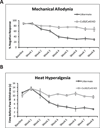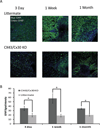Astrocytic CX43 hemichannels and gap junctions play a crucial role in development of chronic neuropathic pain following spinal cord injury
- PMID: 22951907
- PMCID: PMC3604747
- DOI: 10.1002/glia.22384
Astrocytic CX43 hemichannels and gap junctions play a crucial role in development of chronic neuropathic pain following spinal cord injury
Abstract
Chronic neuropathic pain is a frequent consequence of spinal cord injury (SCI). Yet despite recent advances, upstream releasing mechanisms and effective therapeutic options remain elusive. Previous studies have demonstrated that SCI results in excessive ATP release to the peritraumatic regions and that purinergic signaling, among glial cells, likely plays an essential role in facilitating inflammatory responses and nociceptive sensitization. We sought to assess the role of connexin 43 (Cx43) as a mediator of CNS inflammation and chronic pain. To determine the extent of Cx43 involvement in chronic pain, a weight-drop SCI was performed on transgenic mice with Cx43/Cx30 deletions. SCI induced robust and persistent neuropathic pain including heat hyperalgesia and mechanical allodynia in wild-type control mice, which developed after 4 weeks and was maintained after 8 weeks. Notably, SCI-induced heat hyperalgesia and mechanical allodynia were prevented in transgenic mice with Cx43/Cx30 deletions, but fully developed in transgenic mice with only Cx30 deletion. SCI-induced gliosis, detected as upregulation of glial fibrillary acidic protein in the spinal cord astrocytes at different stages of the injury, was also reduced in the knockout mice with Cx43/Cx30 deletions, when compared with littermate controls. In comparison, a standard regimen of post-SCI treatment of minocycline attenuated neuropathic pain to a significantly lesser degree than Cx43 deletion. These findings suggest Cx43 is critically linked to the development of central neuropathic pain following acute SCI. Since Cx43/Cx30 is expressed by astrocytes, these findings also support an important role of astrocytes in the development of chronic pain.
Copyright © 2012 Wiley Periodicals, Inc.
Figures






Similar articles
-
Connexin-43 induces chemokine release from spinal cord astrocytes to maintain late-phase neuropathic pain in mice.Brain. 2014 Aug;137(Pt 8):2193-209. doi: 10.1093/brain/awu140. Epub 2014 Jun 11. Brain. 2014. PMID: 24919967 Free PMC article.
-
Astrocyte sigma-1 receptors modulate connexin 43 expression leading to the induction of below-level mechanical allodynia in spinal cord injured mice.Neuropharmacology. 2016 Dec;111:34-46. doi: 10.1016/j.neuropharm.2016.08.027. Epub 2016 Aug 24. Neuropharmacology. 2016. PMID: 27567941
-
Intrathecal injection of carbenoxolone, a gap junction decoupler, attenuates the induction of below-level neuropathic pain after spinal cord injury in rats.Exp Neurol. 2010 Jul;224(1):123-32. doi: 10.1016/j.expneurol.2010.03.002. Epub 2010 Mar 11. Exp Neurol. 2010. PMID: 20226782
-
The role of connexin43 in neuropathic pain induced by spinal cord injury.Acta Biochim Biophys Sin (Shanghai). 2019 Jun 20;51(6):555-561. doi: 10.1093/abbs/gmz038. Acta Biochim Biophys Sin (Shanghai). 2019. PMID: 31056639 Review.
-
Role of connexins in spinal cord injury: An update.Clin Neurol Neurosurg. 2020 Oct;197:106102. doi: 10.1016/j.clineuro.2020.106102. Epub 2020 Jul 21. Clin Neurol Neurosurg. 2020. PMID: 32717564 Review.
Cited by
-
Coupled cell networks are target cells of inflammation, which can spread between different body organs and develop into systemic chronic inflammation.J Inflamm (Lond). 2015 Jul 25;12:44. doi: 10.1186/s12950-015-0091-2. eCollection 2015. J Inflamm (Lond). 2015. PMID: 26213498 Free PMC article. Review.
-
Astrocytes in Pain Perception: A Systems Neuroscience Approach.Adv Neurobiol. 2024;39:193-212. doi: 10.1007/978-3-031-64839-7_8. Adv Neurobiol. 2024. PMID: 39190076 Review.
-
Connexin Hemichannels in Astrocytes: An Assessment of Controversies Regarding Their Functional Characteristics.Neurochem Res. 2017 Sep;42(9):2537-2550. doi: 10.1007/s11064-017-2243-7. Epub 2017 Apr 22. Neurochem Res. 2017. PMID: 28434165 Review.
-
Intrathecal administration of antisense oligonucleotide against p38α but not p38β MAP kinase isoform reduces neuropathic and postoperative pain and TLR4-induced pain in male mice.Brain Behav Immun. 2018 Aug;72:34-44. doi: 10.1016/j.bbi.2017.11.007. Epub 2017 Nov 8. Brain Behav Immun. 2018. PMID: 29128611 Free PMC article.
-
Glia and pain: is chronic pain a gliopathy?Pain. 2013 Dec;154 Suppl 1(0 1):S10-S28. doi: 10.1016/j.pain.2013.06.022. Epub 2013 Jun 20. Pain. 2013. PMID: 23792284 Free PMC article. Review.
References
-
- Basso DM, Fisher LC, Anderson AJ, Jakeman LB, McTigue DM, Popovich PG. Basso Mouse Scale for locomotion detects differences in recovery after spinal cord injury in five common mouse strains. J Neurotrauma. 2006;23(5):635–659. - PubMed
-
- Bethea JR. Spinal cord injury-induced inflammation: a dual-edged sword. Prog Brain Res. 2000;128:33–42. - PubMed
-
- Brederson JD, Jarvis MF. Homomeric and heteromeric P2X3 receptors in peripheral sensory neurons. Curr Opin Investig Drugs. 2008;9(7):716–725. - PubMed
Publication types
MeSH terms
Substances
Grants and funding
LinkOut - more resources
Full Text Sources
Other Literature Sources
Medical
Molecular Biology Databases
Miscellaneous

